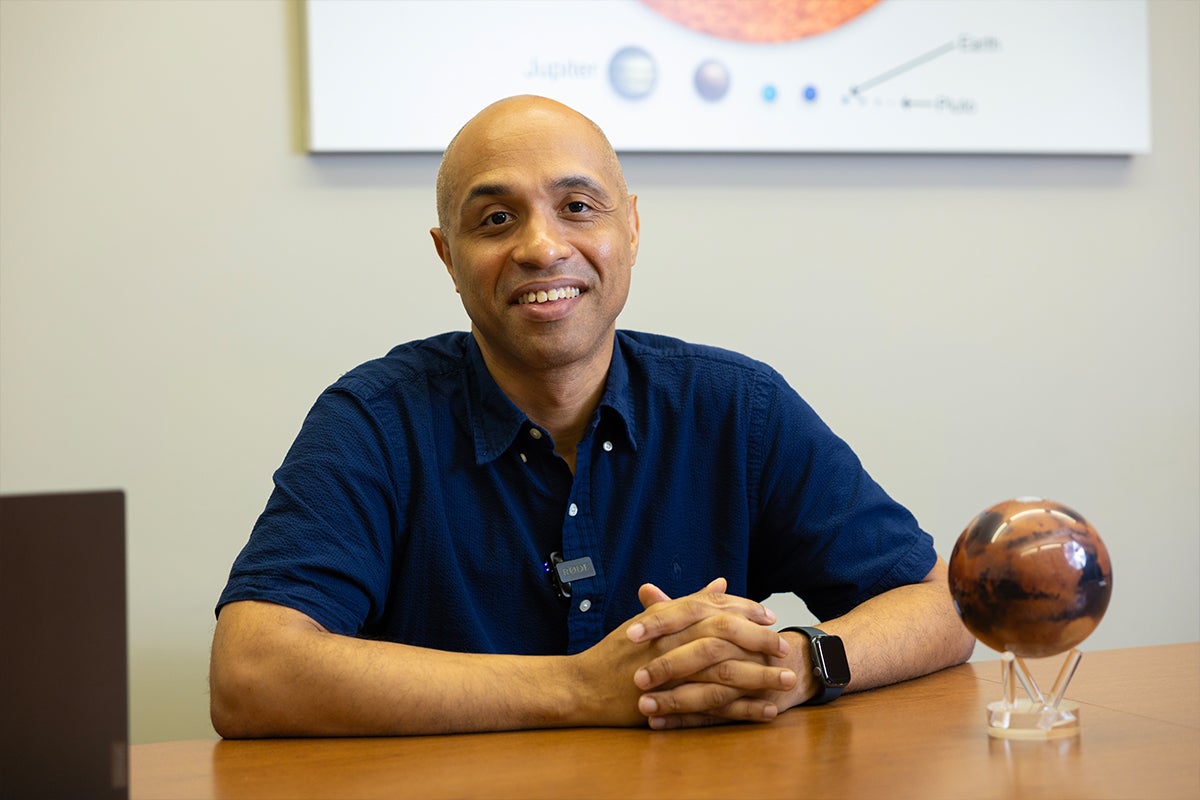Mars remains in humanity’s crosshairs as a promising planet to settle due to its great potential in becoming habitable someday.
With this in mind, UCF Planetary Scientist Ramses Ramirez, in collaboration with researchers at the University of Chicago and Northwestern University analyzed Martian climate models to study the possibility of using Mars-based nanoparticles to warm the atmosphere to accommodate life on Mars.
The research, published this week in the journal Science Advances, found that it may be feasible to fabricate tiny reflective nanorods from iron and aluminum found in the Martian soil and launch them into the atmosphere. There the nanorods would concentrate sunlight onto the surface, triggering a greenhouse effect that produces surface temperatures that may be warm enough for humans to live and work there.
The researchers say they hope it encourages other scientists to consider further exploring the viability of their method.
“It turns out from the calculations that our team has done, that the random scattering of these particles will cause a strong enough greenhouse effect to warm large swaths of the Martian surface,” Ramirez says.
The use of nanoparticles engineered from the Martian soil greatly reduces terraforming costs and eliminates the need to deliver many resources to Mars, Ramirez says. Previous proposed methods considered releasing carbon dioxide – which is very limited on Mars. Others suggested producing chlorofluorocarbons – which are difficult to maintain in high amounts – proving to be a considerable challenge, he says.
“There have been attempts in the past to try to warm Mars using greenhouse gases, but they require many resources to be brought from Earth and there’s the issue of cost,” Ramirez says. “We were trying to find a solution that was more cost effective and also made it possible to live off the land per se using Martian materials.”
How It Would Work
The study states that the proposed nanorods are about 5,000 times more effective at warming Mars than previously considered approaches.
The particles Ramirez and his collaborators theorized are smaller than commercially available glitter and would be activated by being propelled into the atmosphere by ground-based “fountains” that would circulate them around the planet.
“The interaction of those particles with the incoming sunlight would then cause that solar energy to be preferentially forward scattered to the surface,” Ramirez says. “That would then cause a very strong greenhouse effect, and we can warm it up several tens of degrees.”

(Courtesy of Aaron M. Geller, Northwestern, Center for Interdisciplinary Exploration and Research in Astrophysics)
Research Background and Methods
The project was conceived by Edwin Kite, a planetary scientist and associate professor at the University of Chicago, nearly five years ago. Ramirez and Kite had been working together to test their theories, and they had used Ramirez’s single column model to compare to the 3D model from Northwestern University.
Both models proved useful in determining the interaction between the nanorods with the atmosphere of Mars, Ramirez says. Ultimately, both models showed that nanorods are highly effective at warming Mars, the study states.
“The 3D model is very detailed and better at capturing the spatial domain, as well as circulation patterns, but my model is a little simpler and has a lot of the relevant physics,” he says. “With a single column model, you can look at a larger swath of parameter space in less time and assess the effect that solar radiation has on the atmosphere a bit more carefully. So, it was good to pair these approaches and see what the limits of these different models are.”
Ramirez says he’s fascinated at the prospect of potentially settling other planets — especially Mars.
“I think it’s very important to warm Mars’ atmosphere because we should expand,” he says. “I see it as an obligation of humanity. We owe it to ourselves to move beyond our cradle.”
Off-world Settlements
Ramirez says he believes the pursuit of exploring and terraforming other potentially habitable planets has value beyond settlement. These efforts may provide valuable insight into science that could benefit everyday life on Earth, he says.
“It’s good for our own growth as a species to learn technological advancements that may also become spin-offs,” Ramirez says. “The challenge of the Mars terraforming effort would create new technologies that ultimately benefit people here on Earth.”
Although the nature of the study is theoretical and relies on modeling, Ramirez is hopeful that engineers and other scientists can use this knowledge to conduct further experiments and help realize the dream of a Mars settlement.
“This could be great starting point,” he says.
Samaneh Ansari, a graduate student at Northwestern University, served as the lead author and helped to carry out the research as part of the lab of Hooman Mohseni, a professor in the university’s Department of Physics and Astronomy and Electrical and Computer Engineering Department. Kite conceived and carried out the research while writing the manuscript. His former colleague at the University of Chicago, postdoctoral researcher Liam Steele, also designed the research. All researchers helped design the research and contributed content and edits to the final manuscript.
UCF Researcher’s Credentials
Ramirez joined UCF in 2021 and is a planetary scientist and assistant professor within UCF’s Department of Physics who develops theoretical models used to simulate the atmospheres of potentially habitable planets such as Mars. He obtained his bachelor’s in aerospace engineering in 2001 from the Georgia Institute of Technology and his master’s in planetary geology in 2009 from Arizona State University. Ramirez obtained his dual-title doctoral degree in geosciences and astrobiology in 2014 from Pennsylvania State University. Before joining UCF, he worked as a research associate at Cornell University and later as a research scientist at the Earth-Life Science Institute in Tokyo.




